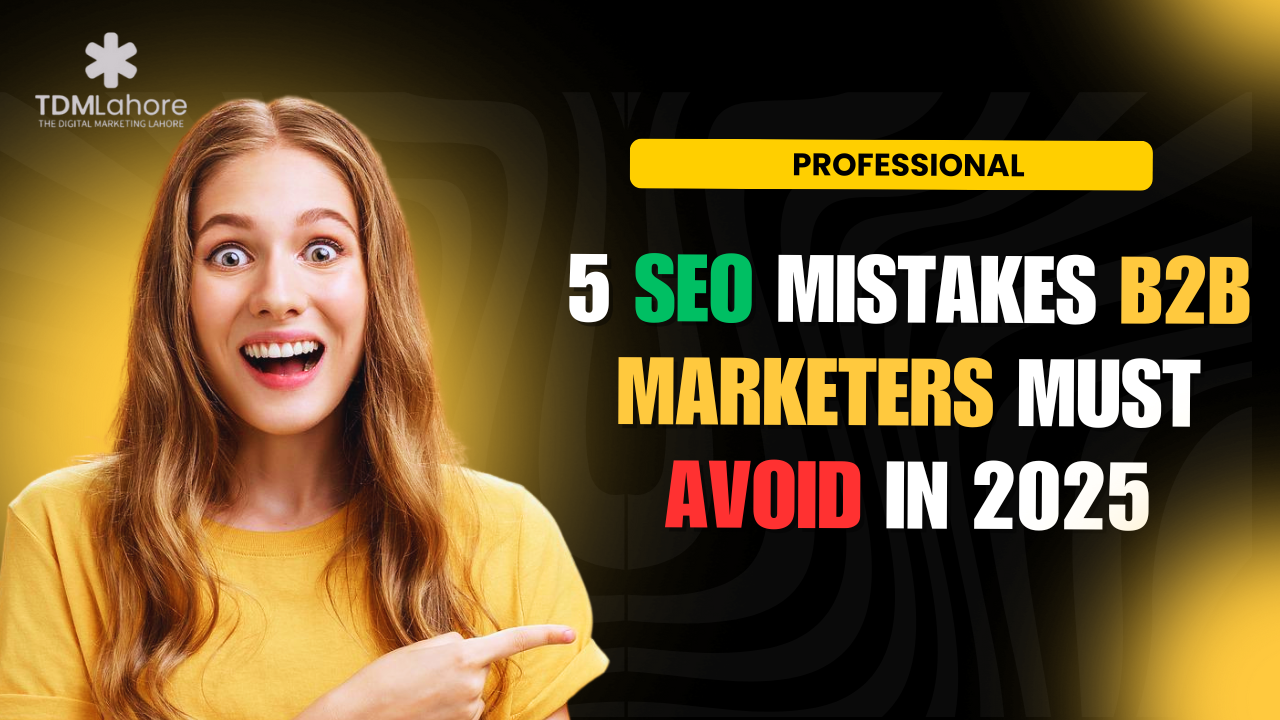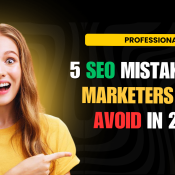
5 SEO Mistakes B2B Marketers Must Avoid in 2025
B2B companies are under more pressure to keep on top of the newest trends and SEO best practices as the digital terrain develops. For B2B marketers, 2025 offers fresh prospects and challenges; nonetheless, some SEO errors still have great influence on the performance of your website. Improving exposure, increasing traffic, and creating leads depend on avoiding these crucial SEO errors regardless of your level of experience in marketing or B2B sector.
Five typical SEO errors that B2B Companies should avoid in 2025 have been found at TDM Lahore Digital Marketing Agency. Let’s explore these traps and talk about how to avoid them so that success would last.
1. Neglecting User Intent in Keyword Strategy
Search engines like Google have evolved in 2025 to be rather skilled in deciphering user intent beyond just keywords. The days of expecting a page to rank just by stuffing it with highly searched for keywords are long gone. Whether the consumer is searching for informational material, product comparisons, or answers to problems, Google’s algorithms increasingly center on giving results that satisfy their demands.
The mistake: Many B2B marketers still concentrate just on ranking for broad or highly sought-after keywords without thinking through the intent behind those searches.
The fix: The corrected is: Start by looking closely at keywords beyond conventional search volume analysis. Know the phases of your customer’s purchasing process and match your material to their needs—that is, whether they are merely investigating or ready to make a purchase. Emphasize long-tail keywords and phrases reflecting user intent, such “best CRM software for manufacturing” rather than merely “CRM software.”
2. Ignoring Mobile Optimization
While mobile optimization has been crucial for some years, it will become absolutely vital in 2025 with 5G and rising mobile internet speeds. Studies reveal that before making judgments on purchases, B2B consumers now do extensive research on mobile devices; Google keeps mobile-first indexing for rankings top priority.
The mistake: The error was One often occurring SEO error is ignoring mobile optimization. Slowness or non-friendliness of B2B websites runs the danger of losing valuable traffic and ranking poorly in search results.
The fix: Making sure your website is totally mobile device friendly and responsive. This covers fast load speeds, a mobile-friendly design, and navigational clarity fit for tiny screens. Check whether your website is mobile friendly with Google’s service.
3. Overlooking B2B Technical SEO
Technical SEO is still the pillar for long-term website performance even if on-page SEO—that which includes keyword use and content optimization—is crucial. As search engines give website speed, security, and crawlability top priority, technical SEO’s complexity will keep rising in 2025.
The mistake: Many business-to—business marketers overlook important technical SEO elements such site structure, internal linking, XML sitemaps, and link mending.
The fix: Routinely looking over your website for technical problems. Discover broken links, missing alt text, slow sites, and mobile responsiveness using tools as Google Search Console, Screaming Frog, or SEMrush. Make sure your website has a quick (under three seconds load times), SSL certificate, optimized XML sitemap to increase crawlability, and securely hosted configuration.
4. Overloading Content with Jargon
Although B2B marketing sometimes entails sophisticated goods and services, it does not imply you should pack your material with industry-specific jargon and language. Although informed, your target audience might not always know every technical word. This can lessen the efficacy of your material and make it less approachable.
The mistake: Writing too complex or jargon-heavy content runs the danger of alienating potential consumers searching for easily absorbed knowledge.
The fix: Try to balance accessibility with authority. Steer clear of too complicated terminology. Rather, write in a style that appeals to your readers by employing exact, succinct language that clarifies difficult ideas without miffing them. To further make your material interesting and break down difficult concepts, add infographics, movies, or charts.
5. Failing to Leverage B2B Local SEO
Although local SEO may appear more pertinent to B2C organizations, it’s growingly crucial for B2B enterprises—especially those with a local or regional presence—also. Local search results are catered to consumers looking for companies nearby, hence your exposure for locally focused queries will be much improved.
The mistake: Many business-to—business marketers overlook local SEO and fail to claim their Google My Business listing or maximize their website for keywords related to their area.
The fix: Optimize your website with specialized keywords targeted at particular towns, areas, or businesses you handle. Claim and often update your Google My Business page to increase local search result visibility. To further establish your regional presence, think about including listing in local directories and interacting with local events or media.
SEO is a dynamic field; in 2025 B2B marketers have to be aware of the changing scene if they are to remain competitive. By avoiding these five typical SEO mistakes—neglecting user intent, ignoring mobile optimization, overlooking technical SEO, cluttering content with jargon, and forgetting to apply local SEO—you may help your website be optimized and bring more visitors, thereby increasing the conversion rate.
Our specialty at TDM Lahore Digital Marketing Agency is helping companies increase their digital presence and SEO. Our staff keeps current with the newest trends and best practices to make sure your website is search engine and user friendly.
FAQs on B2B SEO Mistakes
1. Why is user intent so important in SEO for B2B?
User intent captures the aims of a searcher for their search. Understanding user intent helps B2B marketers to produce materials that precisely meet the needs of their prospects, hence improving engagement, ranking, and conversion rates. Searching for “CRM software,” for instance, could reveal varying degrees of consumer intent—that of informational or transactional—which calls for different kinds of material.
2. How can I improve my website’s mobile optimization?
Start with responsive web design to guarantee your content, pictures, and navigation are all mobile-friendly. Tools like Google’s PageSpeed Insights let you test load speeds and enhance them as well. Give mobile consumers simpler design and faster loading times top priority so that user experience and rankings may improve.
3. What is technical SEO, and why does it matter for B2B?
Technical SEO is backend optimization meant to raise your website’s indexability, crawlability, and general user experience. Important components are improving page load times, repairing broken links, building an XML sitemap, and running HTTPS. Technical SEO is really important since it enables search engines to better grasp your website, hence improving your chances.
4. How do I avoid using too much jargon in B2B SEO content?
Emphasize simple, unambiguous language to help your material be more easily available. For difficult ideas, use straightforward explanations; when needed, offer glossaries or tool instructions for technical words. To help a larger audience grasp ideas visually, you can also design infographics or movies.
5. How do I optimize my site for B2B local SEO?
Use location-based keywords in your content and meta tags to maximize for local SEO. Try to gain backlinks from nearby websites; claim and improve your Google My Business listing; make sure your contact details match across directories. Additionally helping to increase your profile in local search results is interacting with nearby communities or going to local events.
Aware of these SEO errors and acting to avoid them, B2B Companies can keep succeeding in the always shifting digital terrain of 2025 and beyond.




